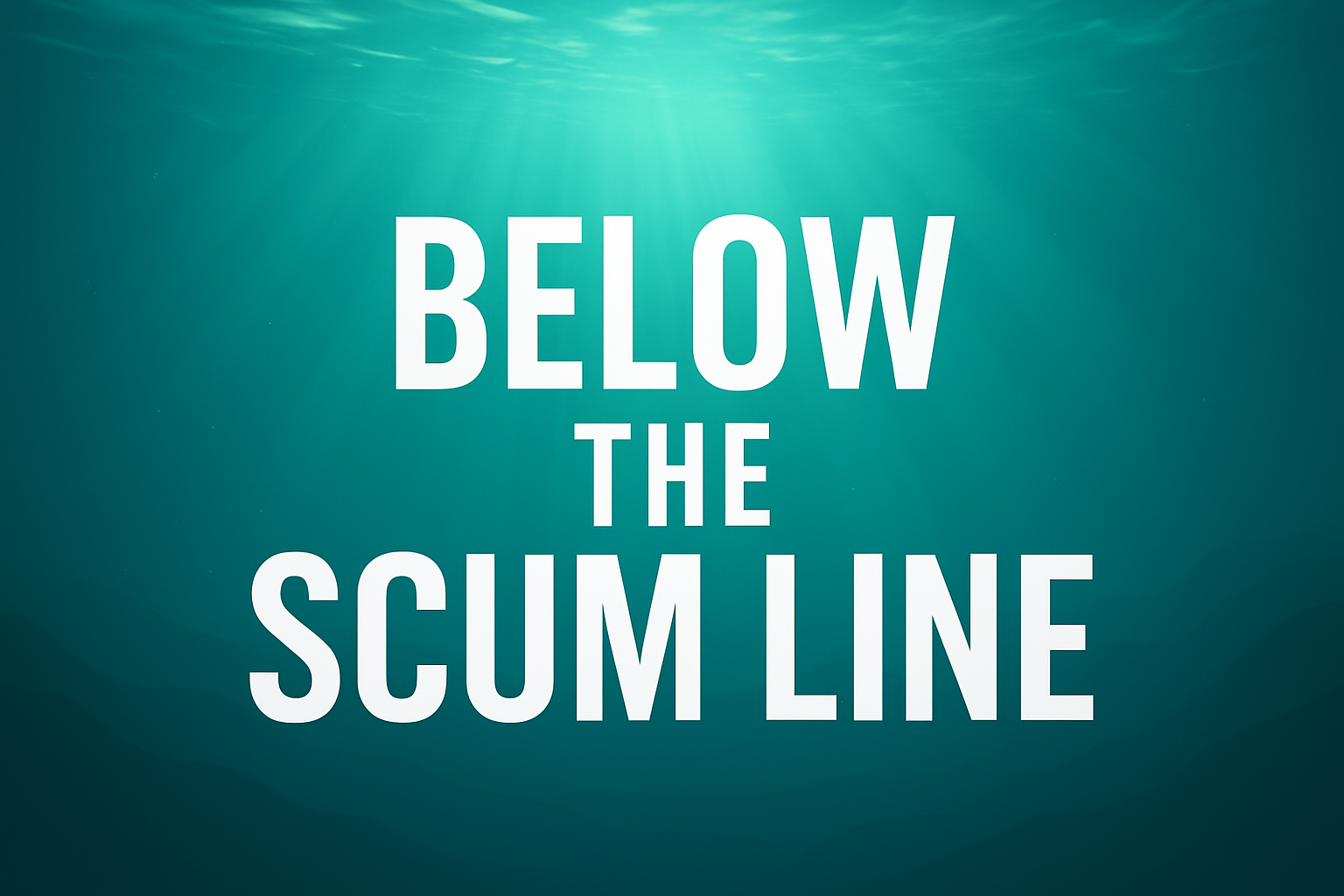Below The Scum Line
As someone who spends their days beneath the waterline keeping hulls clean and vessels performing at their best, I'm constantly fielding questions about what's actually legal when it comes to hull cleaning in Australian waters. It seems there's a sea of confusion out there among mariners and boat owners about the regulations and laws governing our industry.
Whether it's at the marina, during client consultations, or even at industry events, the same questions keep surfacing: "Can I clean my own hull anywhere?" "What chemicals are allowed?" "Do I need permits for commercial cleaning?" "What about environmental restrictions?" The reality is, many well-intentioned boat owners and even some marine professionals are operating under outdated information or complete misconceptions about what's permitted in our waters.
The confusion is understandable – Australian marine regulations can be complex, varying between states and territories, with different rules for recreational versus commercial operations, and evolving environmental protections that many haven't kept pace with. What was acceptable practice five years ago might land you in hot water today, both literally and legally.
In this article, I want to cut through the murky waters of misinformation and provide you with the clear, current facts about hull cleaning regulations in Australia. Whether you're a weekend sailor maintaining your own vessel or a marine professional servicing clients, understanding these rules isn't just about compliance – it's about protecting our marine environment and ensuring the sustainability of our industry for years to come.
In Australia, cleaning a boat’s hull, particularly in-water cleaning, is regulated to prevent environmental harm and the spread of invasive aquatic species through biofouling. Biofouling refers to the accumulation of marine organisms like algae, barnacles, and tube worms on a vessel’s submerged surfaces, which can negatively impact marine ecosystems, water quality, and human health. Below is an overview of the key laws, regulations, and guidelines governing boat hull cleaning in Australia, based on the latest available information:
Key Regulations and Guidelines
-
Australian Anti-fouling and In-Water Cleaning Guidelines:
- The Australian Anti-fouling and In-Water Cleaning Guidelines (2015, with an exposure draft released in 2024) provide best-practice guidance for in-water hull cleaning and the application, maintenance, removal, and disposal of anti-fouling coatings.
- These guidelines are not legally binding but serve as a voluntary framework for regulators to assess biosecurity and chemical contamination risks associated with in-water cleaning in Australian territorial seas.
- Vessel operators and cleaning service providers must contact relevant authorities (e.g., harbour masters, port authorities, or the Department of Agriculture, Fisheries and Forestry) for approval before conducting in-water cleaning, as the guidelines alone do not grant permission.
- The 2024 exposure draft is open for public comment until March 1, 2025, indicating ongoing consultation to refine these standards. Feedback can be submitted to waterquality@dcceew.gov.au.
-
Biosecurity Regulations:
- Under the Biosecurity Act 2015, vessels entering Australian territorial seas must manage biofouling to minimise the risk of introducing invasive aquatic species. Operators are required to report biofouling management practices through the Maritime Arrivals Reporting System (MARS).
- Accepted biofouling management practices include:
- Implementing an effective biofouling management plan.
- Cleaning the hull and niche areas (e.g., propellers, rudders) of all biofouling within 30 days prior to arriving in Australian waters.
- Using approved anti-fouling coatings or systems.
- The Department of Agriculture, Fisheries and Forestry (DAFF) assesses pest biosecurity risks, while other authorities handle chemical contamination or discharge concerns.
-
Environmental Protection Laws:
- The Environment Protection and Biodiversity Conservation Act 1999 (EPBC Act) regulates activities that may impact the environment, including in-water cleaning that could release toxicants or biofouling into marine ecosystems. Operators must ensure compliance with this act when planning hull cleaning.
- In-water cleaning must minimise the release of toxicants (e.g., from anti-fouling paints) to protect water quality and marine life. Some cleaning methods, such as those using environmentally friendly systems like the Envirocart, aim to capture and contain biofouling to prevent pollution.
-
State and Territory Regulations:
- Regulations vary by jurisdiction, and operators must seek approval from state or territory authorities, particularly for cleaning in declared port areas or sensitive marine environments like the Great Barrier Reef Marine Park.
- For example, the Great Barrier Reef Marine Park Authority must be contacted for any in-water cleaning activities within the park, and approvals are subject to strict environmental assessments.
- In Western Australia, companies like CleanSubSea (formerly GRD Franmarine) comply with state biosecurity laws and use systems like the Envirocart to meet environmental standards.
- In Queensland, hull cleaning activities must align with guidelines from the Queensland Department of Agriculture and Fisheries (DAF – Queensland).
-
Australian In-Water Cleaning Standards:
- These standards, under development and expected to replace parts of the 2015 guidelines, specify minimum requirements for in-water cleaning to manage biosecurity and chemical contamination risks. They aim to ensure consistent regulatory decision-making across Australia.
- Regulatory approval is mandatory for in-water cleaning operations, and the standards provide a framework for assessing these activities.
-
International Maritime Organisation (IMO) Guidelines:
- Australia aligns with the IMO’s 2011 Guidelines for the Control and Management of Ships’ Biofouling, which aim to minimise the transfer of invasive aquatic species globally. These guidelines are under review, with updates expected to enhance their effectiveness.
Practical Considerations for Boat Owners
-
In-Water vs. Out-of-Water Cleaning:
- In-water cleaning is heavily regulated due to the risk of releasing biofouling or toxic chemicals into the water. Out-of-water cleaning (e.g., hauling the boat onto land or a slipway) is often preferred as it allows for better control of waste and is less likely to harm the marine environment.
- For out-of-water cleaning, marinas may have designated cleaning areas to prevent chemical runoff into waterways. Using biodegradable, marine-safe cleaning products is recommended.
-
Cleaning Frequency:
- Regular hull cleaning (every 4–12 weeks, depending on water conditions and boat usage) is recommended to prevent excessive biofouling, improve fuel efficiency, and maintain vessel performance.
- For example, in high-fouling areas like Sydney Harbour, cleaning every 6–8 weeks is advised, while racing yachts may require cleaning every 3–4 weeks.
-
Approved Methods and Tools:
- Professional hull cleaning services often use non-abrasive tools (e.g., soft cleaning pads, scrapers) to avoid damaging anti-fouling paint.
- Innovations like underwater drones (e.g., Keelcrab) or systems like the Envirocart are designed to clean hulls without removing anti-fouling paint or polluting the environment.
- For DIY cleaning, environmentally safe products like biodegradable limescale removers or weak acid cleaners (e.g., diluted CLR) are recommended. Protective gear, such as gloves and masks, should paraphrase be used to avoid chemical exposure or injury from barnacles.
-
DIY Cleaning Precautions:
- DIY in-water cleaning is discouraged in many marinas due to environmental regulations under the Clean Water Act or local policies. Check with your marina for specific rules.
- If cleaning in-water, work slowly to avoid exhaustion, use a personal flotation device (PFD), and ensure a helper is present for safety. Avoid releasing toxicants by using gentle tools and environmentally safe cleaners.
- For out-of-water cleaning, rinse the hull with fresh water, use a marine-specific cleaner, and apply UV-resistant wax to protect the hull. Avoid cleaning in direct sunlight to prevent rapid drying of chemicals.
Penalties and Compliance
- Failure to comply with biosecurity or environmental regulations can result in inspections, interventions, or penalties under the Biosecurity Act 2015 or EPBC Act 1999.
- Operators who proactively manage biofouling (e.g., through regular cleaning or effective anti-fouling systems) face fewer interventions from authorities.
Recommendations for Boat Owners
- Contact Relevant Authorities: Before cleaning, consult with the harbour master, port authority, or relevant state/territory regulator (e.g., Great Barrier Reef Marine Park Authority for activities in the park).
- Hire Professionals: Professional hull cleaning services, such as those offered by Evolve Robotic Hull Cleaning, K-ROV, CleanSubSea, or Masterservices Marine, ensure compliance with biosecurity and environmental laws while using advanced tools to protect your vessel.
- Use Approved Products: Choose marine-safe, biodegradable cleaners to minimise environmental impact. Products like Star Brite Instant Hull Cleaner or Cleanaworx Hull Cleaner are designed for safe use on fiberglass and painted surfaces.
- Maintain Records: Keep a biofouling management plan and cleaning records to comply with biosecurity reporting requirements.
- Regular Maintenance: Schedule regular cleanings to reduce fuel costs, enhance performance, and extend the life of anti-fouling paint.
Conclusion
Australian laws on boat hull cleaning focus on minimising environmental harm and preventing the spread of invasive species through biofouling. The Australian Anti-fouling and In-Water Cleaning Guidelines and Biosecurity Act 2015 provide the primary framework, with additional regulations varying by state and territory. In-water cleaning requires regulatory approval due to biosecurity and contamination risks, while out-of-water cleaning is often safer and more compliant. Boat owners should consult relevant authorities, use environmentally friendly methods, and consider professional services to ensure compliance and protect marine ecosystems.
For further details, refer to:
- Australian Anti-fouling and In-Water Cleaning Guidelines: DAFF website
- Biosecurity requirements: Managing Biofouling in Australia
- State-specific regulations: Contact local port authorities or the Great Barrier Reef Marine Park Authority.



Share:
Evolve Newsletter
Hull By Hull